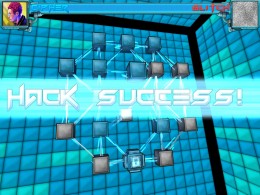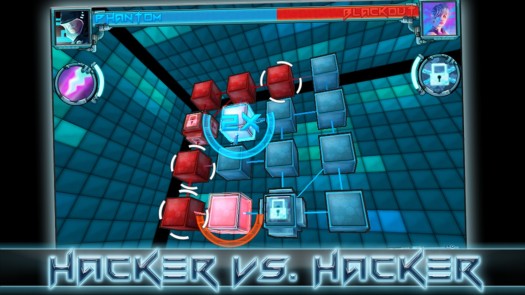 Hacking isn’t much of a competitive sport. There are certainly competitions out there like Pwn2Own, but they don’t look much like Hollywood’s idea of hacking—you know, the bright colours, trippy graphical interfaces and sexy music (and people).
Hacking isn’t much of a competitive sport. There are certainly competitions out there like Pwn2Own, but they don’t look much like Hollywood’s idea of hacking—you know, the bright colours, trippy graphical interfaces and sexy music (and people).
But what if they did?
PWN: Competitive Hacking ($2.99) imagines just such a competition, a tournament that pits Hollywood hacker against Hollywood hacker. They style themselves in cyberpunk accoutrement and have names like Axiom and Cipher. The neurally augmented, the leader of an underground army of hackers, the government agent-turned freedom fighter—these are the sorts of characters that enter the tournament, and that’s about all you’ll ever know of them.
The colorful cast is a campy treat, but it’s just window dressing for the main game: a head-to-head battle for digital territory. The game is played on a grid of linked cubes called nodes. Both players have one node to begin with, and the first to leave the opponent with nothing wins. This isn’t a game of manual dexterity—you only need to tap a node to capture it. The time it takes to be captured is dependent on a couple things, namely the number of connected nodes you’ve already captured and which power-ups you and your opponent have in use.
If you play through the game’s Campaign mode, you begin with a power-up that lets you lock one of your nodes so the enemy has to clear the lock before capturing. Then you pick up others – firewalls that keep your nearby nodes from being targeted by enemy viruses (which take them over) or spikes (which remove them from play), scanners that let you know when an enemy has planted a trojan, overclockers that allow you to capture nearby nodes more quickly and so on. Half the game’s strategy is knowing when and where to pull these out and how to counter (or avoid) them effectively.
The other half is sorting out the lay of the land. One of PWN’s strengths is its massive collection of maps. They range from claustrophobic to massive, with some played on a flat plane and others spread out in 3D. You unlock them as you win battles on them in Campaign mode. Different maps require different approaches—some benefit from a straight rush at the enemy, others are best played by slowly gathering territory and protecting it. The biggest challenge a few of them have to offer is simply understanding what you’re looking at in a 3D space.
 The AI isn’t terribly creative, but it works with what it has. Like you, it starts with one ability and gets more as you work through a character’s campaign. If you play against one of the competitors you’ll need to face their signature power-up, a more dangerous version of one of the regular selection. If you play against a nameless AI, the experience is a little more vanilla.
The AI isn’t terribly creative, but it works with what it has. Like you, it starts with one ability and gets more as you work through a character’s campaign. If you play against one of the competitors you’ll need to face their signature power-up, a more dangerous version of one of the regular selection. If you play against a nameless AI, the experience is a little more vanilla.
Either way, your competitors will advance from slow, plodding territory hunting to quick-reflexed aggression. I won’t lie, the speed got a bit much for me after a few tournaments. So did the repetition—while it’s interesting to start from scratch with a different ability for each chapter of the game, reclaiming the rest over and over gets a bit tired after a while.
If the repetition of the campaign isn’t your speed, you have options. One is Quick Match. This mode grants you the full complement of power-ups on any map you’ve unlocked, or in a single tournament. You can set your difficulty and earn points to increase your hacking rank.
The other option is multiplayer, and that’s where the game is really at home. There, you can pull out all those maps you’ve unlocked. You can define handicaps and limit power-ups—or not. You can play around with the characters you’ve unlocked. But most importantly, you can play against a real person with real strengths and weaknesses, and not a variety of ever-quicker AI opponents.
Multiplayer is also the game’s biggest bummer, though: it’s only available via Bluetooth. Now, this isn’t a game that could be played asynchronously, but head-to-head online multiplayer could be a blast. Tournament support would also be brilliant—single matches are all well and good, but you could get some serious competition going on with an online tournament.
Really, PWN: Combat Hacking is just about where it needs to be—but not quite. The atmosphere has that fun, campy Hackers vibe, but the music gets old and the story is, well, let’s just call it thin. The campaign is fun, but it really has nowhere to go but through the same paths again and again. And the multiplayer—the multiplayer has so much potential, but it’s crippled by the lack of online competitors. It has all the glitz of Hollywood hacking—here’s hoping it picks up a bit of real-life depth.
